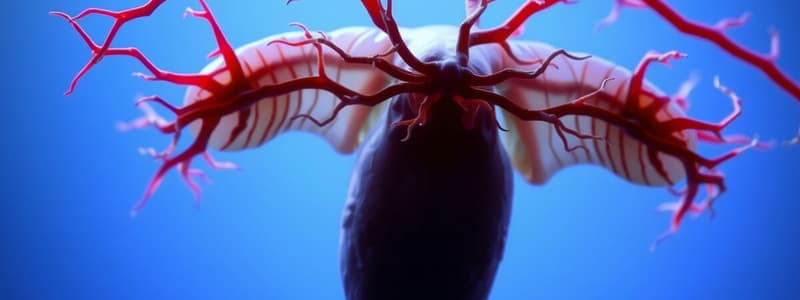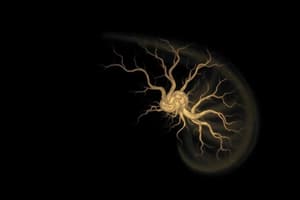Podcast
Questions and Answers
What is the primary function of dendrites?
What is the primary function of dendrites?
- To act as insulators for the neuron
- To transmit nerve signals away from the cell body
- To carry nerve impulses in one direction
- To increase surface area for receiving signals (correct)
The axon is responsible for carrying nerve signals in multiple directions.
The axon is responsible for carrying nerve signals in multiple directions.
False (B)
What protein is secreted by neuroglial cells to aid the growth and survival of neurons?
What protein is secreted by neuroglial cells to aid the growth and survival of neurons?
neurotropins
Myelin is composed of _____% fat and _____% protein.
Myelin is composed of _____% fat and _____% protein.
Which type of glial cell forms the blood-brain barrier?
Which type of glial cell forms the blood-brain barrier?
Myelinated neurons appear gray due to the presence of myelin.
Myelinated neurons appear gray due to the presence of myelin.
What are the nodes of Ranvier?
What are the nodes of Ranvier?
The thickening of the axon helps _____ the propagation of nerve impulses.
The thickening of the axon helps _____ the propagation of nerve impulses.
Match the glial cells with their functions:
Match the glial cells with their functions:
What happens in demyelination diseases?
What happens in demyelination diseases?
Nerve impulses can travel backwards along the axon.
Nerve impulses can travel backwards along the axon.
Name one disease associated with demyelination.
Name one disease associated with demyelination.
Ependymal cells secrete _____ to cushion and protect the brain.
Ependymal cells secrete _____ to cushion and protect the brain.
Which part of the neuron is referred to as the processing center?
Which part of the neuron is referred to as the processing center?
Which embryonic layer gives rise to the nervous system?
Which embryonic layer gives rise to the nervous system?
The optic nerve is considered part of the peripheral nervous system.
The optic nerve is considered part of the peripheral nervous system.
What are the two main divisions of the nervous system?
What are the two main divisions of the nervous system?
The _____ is the structural unit of the nervous system.
The _____ is the structural unit of the nervous system.
Which cells are responsible for myelinating the peripheral nervous system?
Which cells are responsible for myelinating the peripheral nervous system?
A nerve is a collection of dendrites in the central nervous system.
A nerve is a collection of dendrites in the central nervous system.
Name the fastest type of nerve fiber.
Name the fastest type of nerve fiber.
The three parts of the brain stem are the midbrain, _____, and medulla.
The three parts of the brain stem are the midbrain, _____, and medulla.
Match the following components of the nervous system with their roles.
Match the following components of the nervous system with their roles.
Which of the following is true about the reflex arc?
Which of the following is true about the reflex arc?
Myelination increases the speed of nerve impulse conduction.
Myelination increases the speed of nerve impulse conduction.
What are the two subdivisions of the autonomic nervous system?
What are the two subdivisions of the autonomic nervous system?
Cranial nerves and _____ nerves are parts of the peripheral nervous system.
Cranial nerves and _____ nerves are parts of the peripheral nervous system.
Which type of fiber is the slowest?
Which type of fiber is the slowest?
The action potential can travel in both directions along the axon.
The action potential can travel in both directions along the axon.
Flashcards are hidden until you start studying
Study Notes
Nervous System Development
- Derived from ectoderm during embryonic development.
- Trilaminar embryo consists of endoderm, mesoderm, and ectoderm; ectoderm gives rise to neuroectoderm (nervous system) and surface ectoderm (skin, hair, nails).
- Neuroectoderm divides into:
- Neural tube: forms the Central Nervous System (CNS).
- Neural crest: forms the Peripheral Nervous System (PNS).
Myelin and Nerve Cells
- Myelin in the CNS is produced by oligodendrocytes; in the PNS by Schwann cells.
- The nervous system is categorized as:
- Central Nervous System: brain and spinal cord (CNS).
- Peripheral Nervous System: cranial nerves (12 pairs) and spinal nerves (31 pairs).
- The optic nerve is classified as part of the CNS despite being a cranial nerve.
Brain and Spinal Cord Structure
- Brain components include:
- Cerebrum: higher functions.
- Cerebellum: coordination and balance.
- Brainstem: consists of midbrain, pons, and medulla.
- Spinal cord consists of different segments: cervical, thoracic, lumbar, sacral, and coccygeal.
- All spinal nerves are mixed (sensory and motor functions).
Motor and Sensory Systems
- Somatic system: voluntary control over skeletal muscles.
- Autonomic system: involuntary control over glands and organs.
- Neural impulses travel from the brain to muscles (motor) and from sensory organs to the brain (sensory).
Neuron Structure
- Neuron: the fundamental unit of the nervous system, composed of:
- Dendrites: receive signals, increasing surface area for connectivity.
- Cell body (soma): processes information and contains nucleus.
- Axon: transmits nerve signals unidirectionally (orthodromic).
- Myelin: acts as an insulator, increasing signal transmission speed.
Action Potential
- Action potential: the electrical impulse triggering communication between neurons and body functions.
- Nerve impulses are always unidirectional and travel from axon hillock to axon terminals.
- Terminals release neurotransmitters to communicate with target organs (other neurons, muscles, glands).
Myelinated vs. Unmyelinated Fibers
- Myelinated fibers appear white; unmyelinated fibers appear grey.
- Myelination allows for faster impulse conduction through saltatory conduction (jumping of impulses at nodes of Ranvier).
Neuroglial Cells
- Glial cells support and protect neurons, including:
- Oligodendrocytes: produce myelin in CNS.
- Schwann cells: produce myelin in PNS.
- Astrocytes: form the blood-brain barrier, regulating substance entry into the brain.
- Microglia: act as immune cells of the CNS.
- Ependymal cells: line ventricles and secrete cerebrospinal fluid (CSF).
Neurotrophins
- Neurotrophins: proteins produced by glial cells that support neuron growth, development, and survival, especially for axons.
Pathological Considerations
- Demyelination diseases such as:
- Multiple sclerosis: an autoimmune disorder attacking CNS myelin.
- Guillain-Barré syndrome: an autoimmune response affecting PNS myelin.
- The optic nerve's involvement in multiple sclerosis highlights its unique CNS classification.
Studying That Suits You
Use AI to generate personalized quizzes and flashcards to suit your learning preferences.




